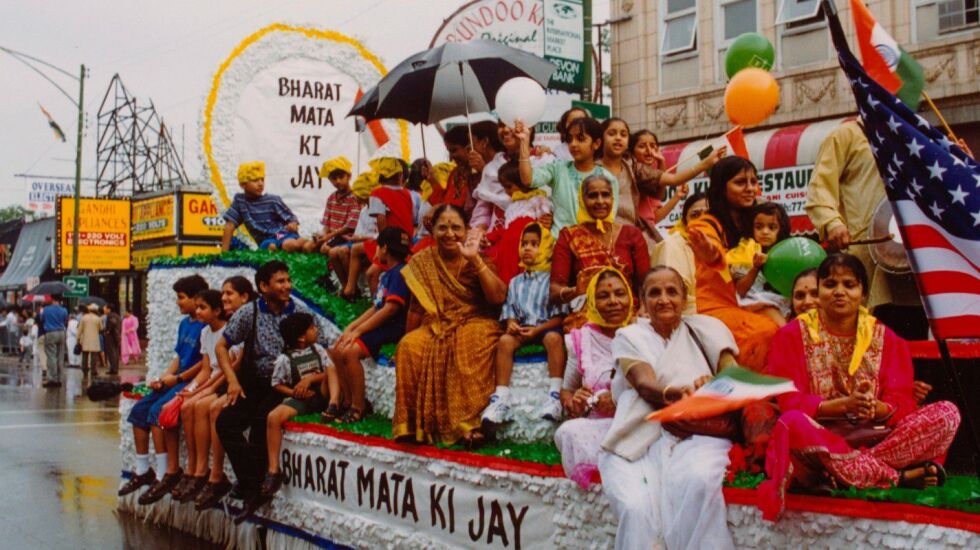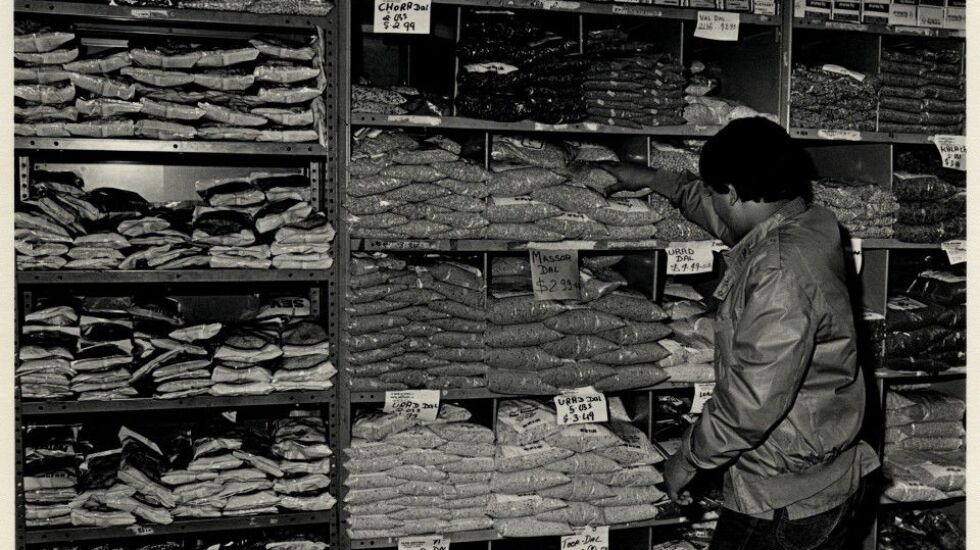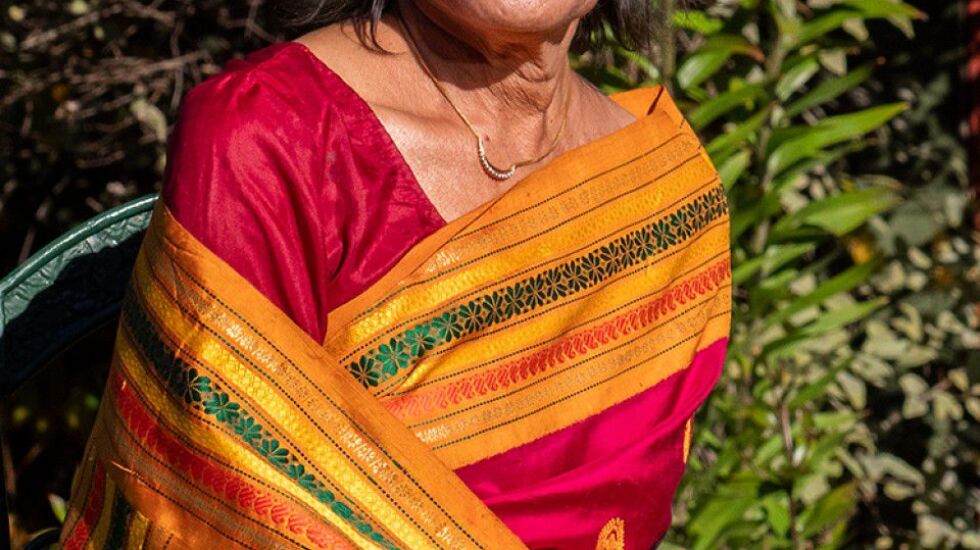
These businesses are clustered on a mile-long stretch of Devon Avenue from about California Avenue on the west to Damen Avenue on the east in West Ridge on the city’s far North Side, an area now commonly known as Little India.
Kumar, a board member of the National Indo-American Museum, visits every time she has a taste for a traditional Indian fudge called Kalakand, which is made with milk and cardamom.
“It’s very comforting knowing that just…14 miles away from my house, there is an essence of Little India,” says Kumar, who lives in Northbrook. “it’s nostalgia for me. With the familiar sights, smells, sounds, you know, flavors of home… I feel like I never moved away after all.”
The neighborhood is one of the most diverse in the city. It’s also a hub for dozens of South Asian businesses, including grocery stores and shops selling saris and jewelry.
Like Kumar, people often come from elsewhere in the city or beyond to eat and shop on this part of Devon Avenue.
So how did Devon Avenue become a primarily Indian community?
Metropolitan Chicago has the second-largest Indian American population and the fourth-largest Pakistani American community in the country, according to 2019 census data analyzed by the Pew Research Center. Two big migration waves from South Asia contributed to demographic shifts in the area.

A first South Asian wave
The community around Devon Avenue wasn’t always home to Indian and other South Asian residents. In the 1950s and 1960s, it was largely Jewish. There’s still a Jewish community though not as big as it was then. An honorary street sign honors the late Israeli Prime Minister Golda Meir, and there are still synagogues, Jewish bakeries and a Jewish Community Center nearby.
The first wave of immigration from South Asia came with the passage of the federal Immigration and Naturalization Act of 1965, which opened doors for highly skilled immigrants to the United States and saw South Asian doctors, engineers and other professionals resettle in Chicago.
Ranjana Bhargava was part of that first wave. She arrived in the summer of 1968 with a master’s degree in psychology. She remembers how hard it was to find vegetarian food in Chicago at the time.
“You know, we went to McDonald’s, so we would say, ‘Give me a hamburger without a burger,’ ” Bhargava says. “And they would look at you. And they would say, ‘What do we charge?’ They didn’t know what to do with us.”
In her 20s then, Bhargava says she wasn’t much of a cook. But, as she learned to make traditional dishes from northern India, she needed to figure out where to find the spices she needed, including cumin and paprika.
“There was no Indian store,” Bhargava says. “There was no Indian restaurant in Chicago at that time. Mexican places had some of those spices. And we could smell it and feel, ‘Yes, they are the right ones.’ ”
She and her husband have lived on the South Side for decades, but she worked in Little India for many years. She says she saw how the neighborhood became an anchor for the Indian community. She was thrilled when the first big sari store opened on Devon Avenue — The Sari Palace. It was followed by other Indian shops primarily centered around Devon Avenue, including the first Indian grocery stores, like Patel Brothers, which opened in the 1970s.

With the new stores came new residents and a community. Once a month, a theater would show Indian movies. People started holding gatherings where they shared Indian food, played Indian instruments and performed traditional dances.

Little India’s second wave
In the 1980s and 1990s, there was a second wave of South Asian migration, this one made up mostly of relatives who were sponsored by family members who had come in the 1960s.
As more Jewish families moved away, to the suburbs, and, with them, some of DevonA venue’s old businesses, South Asian business people took the storefronts they left vacant.
“People started saying, ‘Oh, we can open a store,’ ” Bhargava says. “So there was a jewelry store, and electronics was a very big thing.”
As the area drew new stores and more people, more visitors started coming to sample the cuisines of India and Pakistan.
By the early 2000s, this strip had become a place where South Asian families came to shop and eat before returning home to the suburbs. Some couldn’t afford to buy a home in the area. Others saw living in the suburbs as a sign of prosperity.
Bhargava says most Chicagoans probably would lump South Asians into one nationality — Indians. But, in addition to India and Pakistan, people living and running businesses along Devon Avenue also come from Sri Lanka, Bangladesh, Bhutan and other countries outside South Asia, including Croatia and Syria.

Devon Avenue today
“A lot of businesses do serve a lot of the South Asian population,” says Chirag Shah, community navigator program manager for the Indo-American Center. “But, as we walk up and down Devon … you come across people from 10 different countries.”
Shah, who grew up in the neighborhood, says people who work at the Indo-American Center speak a total of about 15 languages. But he estimates there are twice that many languages spoken in the community.
With so much going on in a relatively small area, hostilities from back home sometimes surface, especially among Indians and Pakistanis.
“There’ll be these moments during the Pakistan in India parade where …young teenage boys had their nationalism moments,” says Mueze Bawany, who was 3 when his family moved to the neighborhood in 1990 from Pakistan. “We used to have some fist fights that will break out.”
Aside from parade disputes and disagreements over cricket matches, Bawany, who is an English teacher and is running for the Chicago City Council to represent the 50th ward, says the tensions never lasted long.
Growing up, Bawany’s friends included orthodox Jews, some who were from India and were Hindu, Sikh or Jain and others from Kosovo, Somalia and Syria.
Shah and others who work in the area say West Ridge, over the past few years, has seen an influx of more immigrants, including South Asians, arriving without resources, many of them undocumented, some fleeing conflict, genocide and poverty.
They find a sense of belonging, Bawany says.
“You can pray here, you can be your culture, wear a sari, wear a headscarf, be as close as you could be to home here,” he says.







